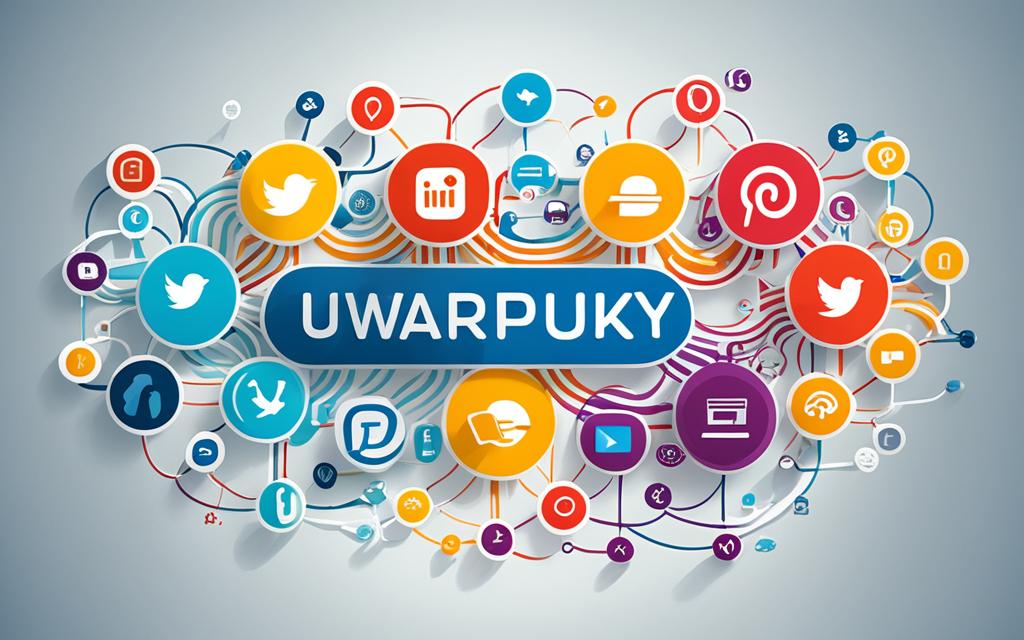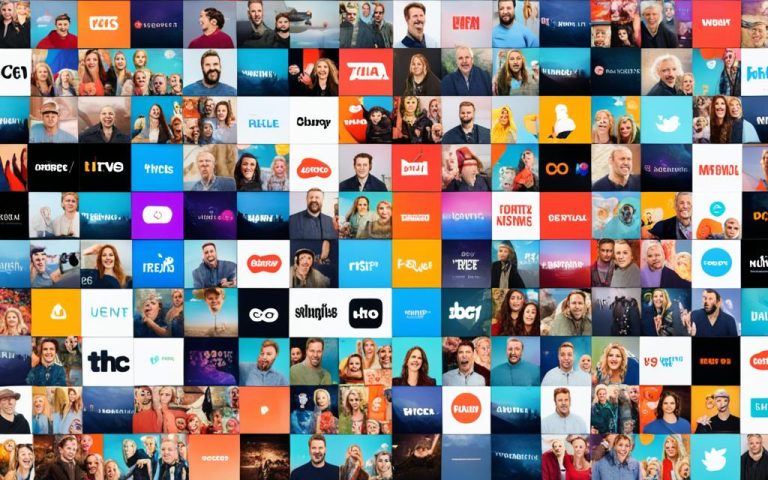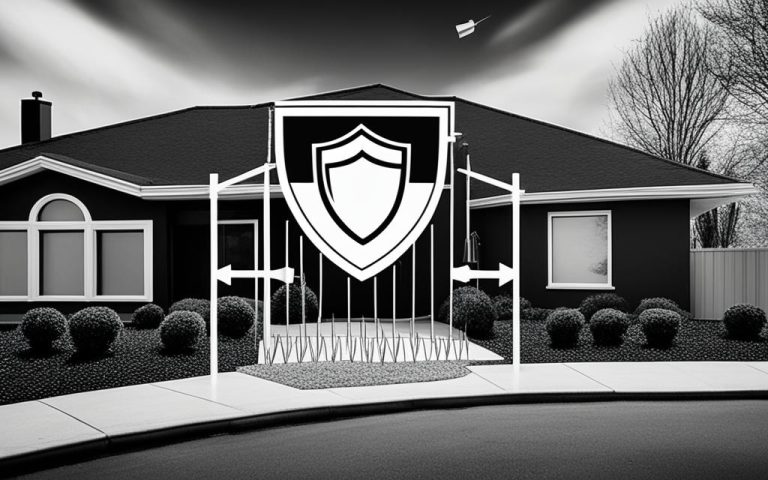Social network URLs are key to a strong online presence. They help individuals and businesses make the most of their online space. This article will cover what social network URLs are, why they matter, and how to use them well.
Key Takeaways:
- Social network URLs are vital for a strong online presence and drawing users to your content1.
- It’s important to format links correctly when sharing them on social media1.
- Using React and styled components can make sharing easier and more engaging1.
- HTTPS encryption is key for secure connections2.
- Using descriptive keywords and hyphens in URLs helps with search engine rankings and makes them easier to read2.
- Removing dates from blog post URLs keeps the content fresh and avoids confusion2.
- Social networks and communities of interest connect people and share knowledge3.
- Healthcare professionals use social networks to share knowledge and manage information3.
What is a Social Network?
A social network is a place online where people and groups can meet, talk, share news, and make friends. It lets people find others who like the same things or live nearby. Social networks are key to the internet, helping us connect, share info, and join communities online.
Since SixDegrees.com started in 19974, social networks have grown a lot. Now, over 4.74 billion people use them worldwide4. On average, each person spends more than two hours a day on these sites4. This shows how popular and widespread social networks are today.
Social networks are great at bringing people together and building relationships. They let us meet new people, share our lives, and feel like we belong. We can keep up with friends, family, and workmates, no matter where they are.
They’re also important for work and business. Many professionals use them to grow their networks, find jobs, and work with others. Companies use them to reach more people, promote what they do, and build their brand.
Sharing content is a big part of social networks. People can post articles, videos, and photos, spreading news fast. These platforms work with blogs, news sites, and online shops, making content go further.
But, social networks have some downsides. False information can spread quickly, causing problems. Studies say false news is often shared more than true news5. So, it’s important to think critically and check facts before believing what we see online.
Keeping user data safe is also a big issue. Data breaches, like the one that hit Facebook in 20214, show the risks. Users need to know how to protect their info and use privacy settings wisely.
In the end, social networks have changed how we connect and share. They help us make friends and work together all over the world. But, we must be careful with the risks, like fake news and privacy issues.
Understanding Social Networking
Social networking is about making and keeping connections in both real life and online. Now, it mainly happens online, thanks to technology and the internet. People use devices like PCs, tablets, or smartphones to stay connected anywhere, anytime.
These platforms use advanced coding and databases to organize and store data. This lets users share posts, updates, and multimedia with each other. It helps people build relationships, share info, and work together on projects or shared interests.
Many people use social networking sites, with LinkedIn having 500 million users and X having 330 million monthly active users. Facebook is the biggest with 2 billion users every month6. This shows how popular and influential social networking is worldwide.
YouTube is a big deal with hundreds of millions of hours watched daily6. Instagram, for sharing photos and videos, sees over 95 million posts daily6. These numbers show how big a part of our lives social networking is, changing how we talk, watch media, and connect with others.
People don’t stick to just one social network. On average, we have seven social media accounts6. Almost 80% of social media use happens on mobile devices, showing how key internet and technology are for social networking on the move6. As we use technology more, social networking has become a key part of our online lives, helping us connect across distances and grow our social circles.
Social networks are also big news sources. The Pew Research Center found 66% of Facebook users get news from the platform6. They also show how social media is important for customer service, with 67% of customers looking for help there6. Social media’s quick and easy access makes it a go-to for businesses and customers for solving problems and answering questions.
Facebook users spend about 50 minutes a day on the platform, showing how engaging it is6. Instagram is especially popular with young adults, with 59% of 18-29-year-olds using it6. This shows how social networking affects people of all ages, helping them communicate and express themselves.
Understanding social networking’s impact is crucial in our connected world. As we keep using technology and the internet to connect, social networking will keep playing a big role in our lives, personal and professional.
Key Features of Social Networks
Social networks stand out because they focus on what users create and share. People post, update their status, and share photos and videos. This makes the online community vibrant and engaging7.
Every user has their own profile. It’s a place to put up their content and share who they are. Users can make their profiles their own, showing off their interests and personality7.
Being able to connect with others is a big deal on social networks. Users can “friend” or “follow” others to grow their circle of friends. This helps people interact and share ideas, building communities online7.
Now, social networks are a big part of our lives. Facebook leads with over 2.96 billion users, followed by YouTube, WhatsApp, Instagram, and WeChat7. These platforms offer lots of features for different interests.
Over time, social networks have changed. SixDegrees.com started it all in 1997, leading to Friendster, MySpace, and Facebook7. Now, we have YouTube, Instagram, LinkedIn, Reddit, Snapchat, Tumblr, Pinterest, and TikTok for specific interests78.
| Key Features of Social Networks | Examples |
|---|---|
| User-Generated Content | Posts, status updates, multimedia content |
| Profiles | Centralized pages for users, customization options |
| Connections | “Friending” or “Following” other users |
| Popular Social Networking Services | Facebook, YouTube, WhatsApp, Instagram, WeChat |
| Evolution of Social Networking | SixDegrees.com, Friendster, MySpace, Facebook |
| Specialized Social Networking Services | YouTube, Instagram, LinkedIn, Reddit, Snapchat, Tumblr, Pinterest, TikTok |
Social networks let people show who they are, connect with others, and join different communities. They offer a way to share content, customize profiles, and connect with others. As these platforms grow, they change how we talk, share, and make friends online.
Types of Social Networking
Social networking platforms vary, each with its own purpose and user needs. Let’s look at some top types of social networking platforms:
Social Connections
Some networks focus on building social connections. Users can connect with friends, family, and even brands. These platforms let people share life updates, photos, and thoughts. Facebook, for instance, has nearly 2 billion users every month9.
Professional Connections
Professional networks help with business and career growth. LinkedIn is the biggest site for this, letting professionals connect, find jobs, and show off their skills10. It has 364 million members as of October 2016, making it a key place for professional networking.
Multimedia Sharing
Some platforms focus on sharing photos, videos, and music. Instagram is big for fashion and food lovers10. YouTube is the top site for videos, offering news and tutorials10. These sites let users be creative, join communities, and explore different media.
News/Informational
Other networks are all about news and sharing information. Twitter is a key platform for quick updates and chats with brands. It had over 330 million users in March 20179. These sites help users stay up-to-date and join discussions on many topics.
Communication
Some platforms focus on chatting in real-time. WhatsApp is a top messaging app, with 1 billion users by February 20179. It offers messaging, voice calls, and video calls, keeping people connected across the globe.
Educational
There are networks for learning too. They offer courses, forums, and sharing resources. Students, teachers, and professionals can meet, share ideas, and find learning materials. These platforms help expand learning opportunities.
Knowing the different types of social networks helps users pick the right ones for their goals. This enriches their online life.
Advantages and Disadvantages of Social Networking
Social networking sites have many benefits for both people and businesses. They help increase brand awareness and connect with people all over the world. This can greatly improve brand awareness11. Businesses can talk to customers right away, share products, and build a strong following11. They also offer a great way to use marketing strategies, targeting specific groups with their messages.
But, social networking also has its downsides. One big issue is how fast rumors and misinformation can spread, hurting people and companies12. Bad reviews and comments can also damage a company’s image, needing quick and careful handling. Another big worry is data security and privacy concerns, as people share a lot of personal info, making them vulnerable to breaches12.
Also, managing social media can take a lot of time, especially for businesses wanting to stay active and engaged online. It’s important to have the right resources to keep up with social media, ensuring good results and avoiding problems. So, it’s key for people and companies to think about the good and bad of social networking before deciding how to use it.
| Advantages | Disadvantages |
|---|---|
|
|
Advantages:
- Social networking makes brands more visible and helps connect with people worldwide.
- It lets businesses talk to customers right away, which builds loyalty.
- Having a strong following on social media means having a group of loyal supporters.
- It’s a great way to use marketing, targeting specific groups with ads.
Disadvantages:
- Rumors and false info can spread fast, hurting people and businesses.
- Bad reviews and comments can hurt a company’s reputation, needing quick action.
- Sharing personal info online raises big privacy concerns, making users vulnerable.
- Managing social media takes a lot of time and effort.
Social Networks in Business
Today, businesses see the huge value of social networks. They use them to improve their customer research, engagement, and marketing.
Social networks let businesses talk directly with customers. They build a brand community and make customers loyal. They can also target ads to reach the right people at the right time13.
These networks help businesses learn what customers think. By watching social media, companies can quickly answer customer questions or worries13. This feedback helps improve products and services, leading to innovation and growth.
Some companies use social networks for their teams too. They create internal networks for employee engagement and sharing info across teams. This helps employees work together better and share knowledge.
Since the 2000s, more businesses use social networks for marketing. They like it because it’s cheaper than old ads like radio or TV13.
Social networking builds brand loyalty by creating a community feeling. It makes companies seem more human and personal. By talking with customers online, businesses can make stronger bonds with their audience13.
It also brings more visitors to websites and can help with search engine rankings. Sharing links and using SEO can increase traffic and sales13.
| Social Network | Steps for Obtaining URLs |
|---|---|
| 3 Steps | |
| 4 Steps | |
| Facebook (personal account) | 3 Steps |
| Facebook (managed pages) | 5 Steps |
| LinkedIn (personal) | 6 Steps |
| LinkedIn (business) | 4 Steps |
| YouTube | 4 Steps |
| 3 Steps |
The table shows different steps to get social network URLs14. Businesses need to follow these steps to be seen on social networks and reach more people.
Social networks give businesses many chances to connect with customers, build communities, and market effectively. By using social networks well, businesses can grow and succeed in today’s digital world.
Implementing Social Network URLs
Setting up social network URLs is key to having an online presence. By picking the right usernames and names, people and businesses can connect with their audience. This boosts brand visibility and helps build strong online communities for marketing success.
Optimizing Social Network Usernames and Account Names
Choosing the right usernames and names is vital for a strong online brand. They should match the brand and message you want to share. Being consistent across all platforms makes it easy for people to find and recognize you.
Importance of Social Sharing Links
*15* Studies show 60% of content is shared before being read, highlighting the need for social sharing links. These links let readers share content easily, increasing visibility and reach.
Strategic Placement of Social Media Icons
*15* Putting social media icons in the right spots is key for visibility. They work well in the footer, header, and sidebar. By customizing these icons, businesses can make their online presence appealing and easy to use.
Networking Platforms and Supported Social Icons
*16* Many social media platforms like Facebook and Instagram can be included in social links menus. This gives a wide range of options for a strong online presence. Icons for Twitter, Facebook, Instagram, LinkedIn, and YouTube let users show off their social media on websites.
Enhancing Web Visits through Social Sharing
*15* Using social sharing icons on blogs encourages visitors to share content, boosting reach and engagement. Making sure the title, description, and image are optimized helps improve visibility on Google and social platforms, bringing in more visitors.
User-Friendly Setup and Compatibility Considerations
*16* Creating social links menus is easier with guides, tutorials, and instructions for different interfaces. This flexibility lets users set up social links menus that fit their skills and preferences. It’s also important to consider compatibility with the website’s theme for a smooth setup.
Social Network Profiles and Customization Challenges
*17* Social networks have different challenges for customizing profiles. For example, Facebook gives random URLs or ones based on the page name. Twitter has a 15-character limit for usernames. LinkedIn makes it easier for individuals but harder for companies. Instagram lets users personalize their usernames, but it takes time to confirm availability.
Using social network URLs is key to building and keeping an online presence. By optimizing usernames, placing social media icons wisely, and using social links menus, people and businesses can succeed in the digital world. This helps build online communities and boosts marketing efforts.
Conclusion
In today’s digital world, knowing how to use social network URLs is key. It helps people and businesses grow their online presence. By using social networks well, you can reach people all over the world and build strong connections.
Studies show that many people, like child psychologists and graduate students, use social networks to connect with others18. Even psychologists use these platforms to talk with their clients. Sites like Second Life let users create avatars for more real-like chats.
Looking at the tech side, it’s clear that making websites fast is important19. Slow websites can make users wait up to 7.7 seconds for pages to load. This is why it’s crucial to optimize website performance by managing social sharing scripts carefully.
For brands, having the same social media handle everywhere is vital20. It helps with visibility, marketing, and making users happy. Using short, easy-to-remember usernames and sticking to character limits is smart. Sometimes, using different names when needed is also a good strategy.
FAQ
What is a social network URL?
A social network URL is a web address that takes users to a specific profile or page on a social networking site. This includes places like Facebook or LinkedIn.
Why is a social network URL important for online presence?
It’s key for online presence because it links directly to a person or business’s profile. This makes it easy for others to find and connect with them.
How can social network URLs be utilized?
People and businesses use social network URLs to set up and manage their online presence. They interact with their audience and share content through posts and updates.
What is a social network?
A social network is a digital place where users and groups connect, share info, and form relationships. They do this based on shared interests, locations, or connections.
What is social networking?
Social networking means making connections and building relationships, both in real life and online. It’s done with technology and the internet.
What are the key features of social networks?
Social networks focus on content made by users, profiles that share info, and connecting with others. These features support social interactions, sharing info, and finding new connections.
What are the different types of social networking?
Social networking comes in many types. Some focus on social connections, others on professional networking, sharing multimedia, news, communication, or education.
What are the advantages and disadvantages of social networking?
Social networking has perks like boosting brand awareness and reaching a global audience. It helps build a following and supports marketing. But, it can spread rumors, hurt business reputations, raise data security concerns, and be time-consuming.
How can businesses leverage social networks?
Businesses use social networks to improve customer research, engagement, and marketing. They connect directly with their audience, use targeted ads, build brand communities, and share info within the company.
How can social network URLs be implemented?
To use social network URLs, create and use usernames and account names on different social platforms. This helps individuals and businesses manage their online presence, reach their audience, and interact with them through posts and content.
Source Links
- https://dev.to/dsasse07/implementing-a-social-share-feature-jd7 – Implementing a Social Share Feature
- https://designpowers.com/blog/url-best-practices – URL Structure: Best Practices for SEO-Friendly URLs › Design Powers
- https://www.healthknowledge.org.uk/public-health-textbook/organisation-management/5b-understanding-ofs/social-networks – Social networks and communities of interest
- https://www.techtarget.com/whatis/definition/social-networking – What is social networking and how does it work? – TechTarget Definition
- https://www.investopedia.com/terms/s/social-networking.asp – What Is Social Networking?
- https://univcomms.ucsd.edu/departments/public-relations/social/social-101/index.html – Social Media 101
- https://www.investopedia.com/terms/s/social-networking-service-sns.asp – Social Networking Service (SNS): Characteristics and Risks
- https://opentextbooks.library.arizona.edu/hrsmwinter2022/chapter/special-topics-from-networks-to-online-communities/ – Social Networks and Online Communities
- https://synapsereality.io/what-are-the-different-types-of-social-media/ – What Are the Different Types of Social Media? – Synapse
- https://maktagg.com/en/types-of-social-networks-what-are-they-and-what-are-they-for/ – What are the types of social networks?
- https://www.lifespan.org/lifespan-living/social-media-good-bad-and-ugly – Pros and Cons of Social Media
- https://webandcrafts.com/blog/social-media-advantages-and-disadvantages – Top 20 Advantages and Disadvantages of Social Media in 2024
- https://corporatefinanceinstitute.com/resources/management/social-networking/ – Social Networking
- https://faq.cyberimpact.com/en/articles/248/find-your-links-for-your-different-social-networks – Sharing and social networks | Find your links for your different social networks
- https://showit.com/website-tips/where-to-put-social-media-links-on-your-website-and-why-you-should/ – Where to Put Social Media Links on Your Website (And Why You Should) – Showit
- https://wordpress.com/support/menus/social-links-menu/ – Create a Social Links Menu
- https://savoirfaire-us.com/blog/create-custom-social-network-urls/ – Social Network URLs | What Is Social Network URLs
- https://www.sciencedirect.com/topics/psychology/social-networking – Social Networking – an overview
- https://jonsuh.com/blog/social-share-links/ – Responsible Social Share Links
- https://whatagraph.com/blog/articles/social-media-handles – What Are Social Media Handles?



















